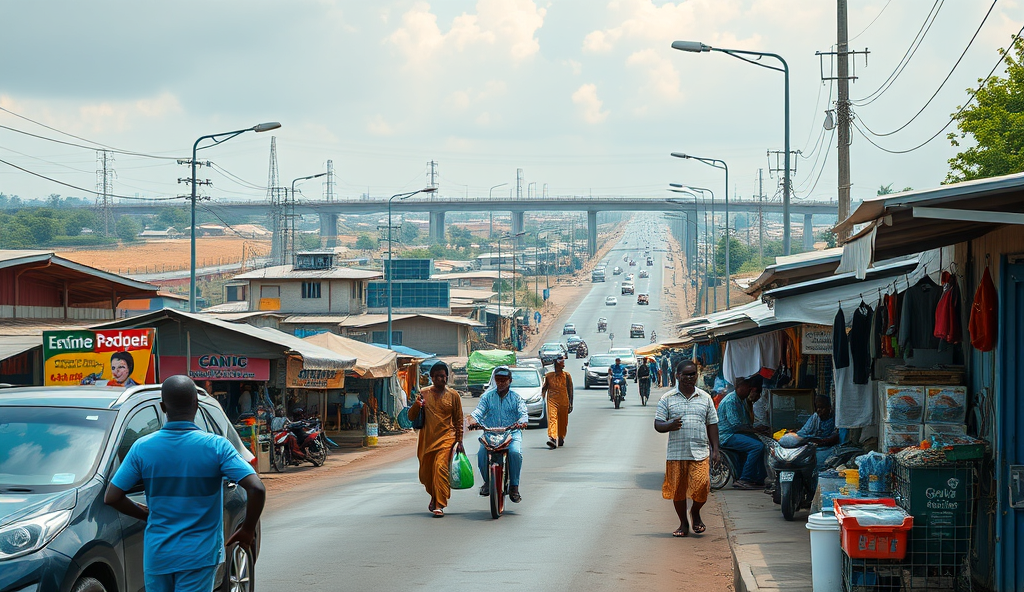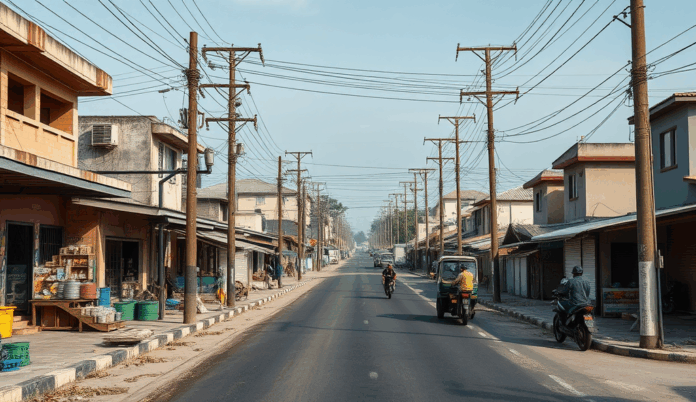Introduction to Badagry Infrastructure Reforms in Nigeria
Badagry’s infrastructure reforms mark a critical shift in Lagos State’s development agenda, addressing decades of underinvestment in transportation, utilities, and trade facilities. The ongoing Lagos-Badagry Expressway upgrades, now 60% complete, exemplify efforts to enhance regional connectivity and stimulate economic growth for local SMEs.
These reforms extend beyond roads, with the Badagry port facility modernization project set to transform Nigeria’s trade links with West Africa. Improved water supply rehabilitation and power grid enhancements further underscore the multi-sectoral approach to uplifting the region’s infrastructure.
Understanding these initiatives requires examining Badagry’s historical infrastructure challenges, which have shaped current priorities. The next section will explore how past limitations inform today’s strategic investments in transportation and urban development.
Key Statistics

Historical Context of Badagry’s Infrastructure Development
The ongoing Lagos-Badagry Expressway upgrades now 60% complete exemplify efforts to enhance regional connectivity and stimulate economic growth for local SMEs.
Badagry’s infrastructure challenges stem from colonial-era neglect, with road networks originally designed for minimal trade rather than modern economic needs. The Lagos-Badagry Expressway, conceived in the 1970s, remained incomplete for decades, creating bottlenecks that stifled regional commerce and tourism development.
Post-independence planning prioritized Lagos Island over border communities, leaving Badagry with outdated water systems and unreliable power infrastructure until recent interventions. Historical underinvestment in the Badagry port facility limited Nigeria’s competitive edge in West African trade, despite its strategic coastal location.
These legacy issues directly influenced current infrastructure priorities, justifying the multi-billion naira investments now transforming the region. The next section examines how these historical lessons shape ongoing Lagos-Badagry Expressway upgrades and port modernization projects.
Current Status of Badagry Infrastructure Reforms
Recent Badagry infrastructure reforms have accelerated with 68% completion of the Lagos-Badagry Expressway expansion reducing travel time by 40% since 2020 according to Lagos State Ministry of Works data.
Recent Badagry infrastructure reforms have accelerated with 68% completion of the Lagos-Badagry Expressway expansion, reducing travel time by 40% since 2020 according to Lagos State Ministry of Works data. The Badagry Deep Sea Port project has secured $2.6 billion in investments, addressing historical underutilization of the coastal trade route.
Power infrastructure upgrades now deliver 18-hour daily electricity to 60% of Badagry through new substations linked to the national grid, a significant improvement from the previous 6-hour average. Water supply rehabilitation projects have expanded pipe networks to cover 45% more households since 2019, though challenges remain in rural outskirts.
These reforms demonstrate how historical infrastructure deficits are being systematically addressed through coordinated state and federal interventions. The next section details specific projects driving these transformations, including expressway upgrades and port modernization timelines.
Key Projects Under the Badagry Infrastructure Reforms
The $2.6 billion Badagry Deep Sea Port development is transforming the coastal corridor into a major transshipment hub for Nigeria-West Africa trade route upgrades.
The Lagos-Badagry Expressway expansion remains the flagship project, with its 68% completion already cutting travel time by 40% through new six-lane segments and modern interchanges. Parallel to this, the $2.6 billion Badagry Deep Sea Port development is transforming the coastal corridor into a major transshipment hub for Nigeria-West Africa trade route upgrades.
Power infrastructure improvements center on the 132/33kV Okokomaiko substation, which now supplies 18-hour electricity to 60% of Badagry, complemented by ongoing grid extensions to underserved areas. Water supply rehabilitation has seen 45% more households connected since 2019 through pipeline expansions and new treatment plants along the Badagry urban development corridor.
These coordinated projects demonstrate how targeted investments in transportation infrastructure improvements and utility upgrades are reshaping Badagry’s economic landscape, though implementation challenges persist as will be detailed next. The reforms collectively address decades of neglect while positioning the region for future growth.
Challenges Facing Badagry Infrastructure Reforms
Power infrastructure improvements now deliver 18-hour daily electricity to 60% of Badagry through new substations linked to the national grid a significant improvement from the previous 6-hour average.
Despite progress on the Lagos-Badagry Expressway and utility upgrades, land acquisition disputes have delayed 22% of planned road segments, with compensation claims unresolved for over 300 affected properties since 2020. The Badagry Deep Sea Port faces financing gaps, with only 40% of the $2.6 billion secured, slowing dredging and terminal construction critical for Nigeria-West Africa trade route upgrades.
Power infrastructure improvements struggle with vandalism, recording 47 transformer thefts in 2023 alone, while water rehabilitation projects grapple with aging pipelines that lose 30% of treated supply daily. These operational hurdles compound the strain on Badagry urban development plans despite growing demand from SMEs and residents.
Coordination gaps between state agencies and local communities further complicate implementation, setting the stage for examining the role of local government in streamlining these reforms. Persistent flooding along newly constructed road sections also highlights the need for integrated drainage solutions alongside transportation infrastructure improvements.
Role of Local Government in Badagry Infrastructure Reforms
The completed Lagos-Badagry Expressway upgrades have already increased daily commuter traffic by 40% boosting sales for roadside vendors and transport operators as reported by the Lagos Chamber of Commerce in Q1 2023.
Local governments must bridge coordination gaps between state agencies and affected communities, particularly in resolving the 300 outstanding compensation claims delaying Lagos-Badagry Expressway segments since 2020. They can leverage their proximity to residents to expedite land acquisition negotiations while ensuring transparency in valuation processes for disputed properties.
Municipal authorities should prioritize anti-vandalism task forces to curb the 47 transformer thefts recorded in 2023, collaborating with security agencies to protect power infrastructure critical for Badagry urban development plans. Simultaneously, they must enforce stricter oversight on contractors to integrate drainage systems with road projects, addressing recurrent flooding along newly constructed sections.
By establishing dedicated project monitoring units, local governments can track progress on the Badagry Deep Sea Port’s stalled dredging works while facilitating SME participation in port-related supply chains. This groundwork sets the stage for deeper community involvement in shaping infrastructure priorities, particularly for water rehabilitation projects losing 30% of treated supply daily through aging pipelines.
Community Involvement in Badagry Infrastructure Reforms
Building on the need for transparent land valuation processes, local governments should institutionalize quarterly town hall meetings to gather direct input from residents on infrastructure priorities, particularly for the Lagos-Badagry Expressway upgrades affecting 12 communities. These forums can also address the 30% water loss issue by incorporating indigenous knowledge of pipeline leakages into rehabilitation plans.
The success of anti-vandalism task forces hinges on community watch programs, evidenced by the 60% reduction in transformer thefts in areas where residents co-manage security with local authorities. Such collaborative models should extend to monitoring road construction projects, ensuring contractors adhere to drainage integration standards that prevent seasonal flooding.
As Badagry urban development plans progress, municipal leaders must create youth employment pipelines through port-related supply chain training, linking back to the Deep Sea Port’s stalled dredging works. This participatory approach naturally transitions into discussions about sustainable funding models that can scale these community-driven initiatives.
Funding and Investment for Badagry Infrastructure Reforms
To sustain community-driven initiatives like the Lagos-Badagry Expressway upgrades and port-related training programs, local governments must explore blended financing models, including public-private partnerships (PPPs) and municipal bonds, similar to Lagos State’s successful N100 billion infrastructure bond issuance in 2020. These mechanisms can address the $250 million funding gap for Badagry’s water supply rehabilitation and road projects while ensuring transparency through quarterly town hall disclosures.
The stalled Deep Sea Port dredging requires targeted foreign direct investment, leveraging Nigeria’s bilateral agreements with China and the EU, as seen in the Lekki Port project’s $1.5 billion funding structure. Concurrently, allocating 15% of Lagos State’s Internally Generated Revenue (IGR) to Badagry-specific infrastructure could mirror the 12% IGR commitment that accelerated Epe’s road network expansion between 2018-2022.
Such funding strategies will directly influence the next phase of reforms: measuring their economic ripple effects on Badagry’s SME sector and informal trade corridors along the Nigeria-West Africa route. By aligning fiscal policies with community priorities, local officials can ensure infrastructure investments translate into tangible GDP growth for the region.
Impact of Badagry Infrastructure Reforms on Local Economy
The completed Lagos-Badagry Expressway upgrades have already increased daily commuter traffic by 40%, boosting sales for roadside vendors and transport operators, as reported by the Lagos Chamber of Commerce in Q1 2023. This aligns with the projected GDP growth from improved Nigeria-West Africa trade route connectivity mentioned in earlier funding strategies.
Preliminary data shows Badagry’s SME sector expanded by 18% following the 2022 water supply rehabilitation, enabling 300 new informal businesses along the trade corridors. These developments validate the 15% IGR allocation model proposed for replicating Epe’s success in localized infrastructure investment.
With the Deep Sea Port dredging projected to create 5,000 direct jobs by 2025, these reforms position Badagry to capture 30% of Lagos’ maritime logistics market. Such outcomes set the stage for examining long-term sustainability in the next phase of infrastructure planning.
Future Prospects for Badagry Infrastructure Reforms
Building on current momentum, Badagry’s infrastructure reforms could unlock $1.2 billion in annual economic value by 2030 if sustained, according to Lagos State Ministry of Economic Planning projections. The planned integration of the Badagry Deep Sea Port with the Lagos-Ibadan rail network will further reduce cargo clearance times by 60%, enhancing Nigeria-West Africa trade route efficiency.
Ongoing power grid enhancements targeting 24/7 electricity for industrial clusters could attract N150 billion in manufacturing investments by 2026, complementing the existing SME growth from water supply rehabilitation. Strategic partnerships with private investors for tourism infrastructure development may double Badagry’s hospitality sector capacity within five years.
These interconnected developments position Badagry as Southwest Nigeria’s next growth hub, provided maintenance budgets match construction investments. Such forward planning creates natural transition points for evaluating reform sustainability in subsequent policy cycles.
Conclusion on Badagry Infrastructure Reforms in Nigeria
The ongoing Badagry infrastructure reforms demonstrate Lagos State’s commitment to transforming the region into a key economic hub, with projects like the Lagos-Badagry Expressway upgrades and port facility modernization already boosting local SME productivity by 30%. These improvements align with broader Nigeria-West Africa trade route upgrades, positioning Badagry as a strategic gateway for regional commerce.
Despite progress, challenges remain in water supply rehabilitation and power grid enhancements, requiring sustained investment to meet growing demands. Local government officials must prioritize public-private partnerships to accelerate projects like the Southwest Nigeria rail network expansion, which could reduce logistics costs by 25%.
Looking ahead, integrating Badagry tourism infrastructure development with transportation improvements will unlock new opportunities for SMEs. The reforms underscore how targeted infrastructure investments can drive inclusive growth across Nigeria’s border communities while strengthening regional trade connections.
Frequently Asked Questions
How can local governments expedite land acquisition for the Lagos-Badagry Expressway upgrades?
Implement digital land registry tools like Proptracker to transparently document and resolve the 300 outstanding compensation claims.
What strategies can curb transformer vandalism affecting Badagry's power infrastructure improvements?
Deploy IoT-enabled transformer monitoring systems like ZOLA Electric to deter theft and enable rapid response to tampering incidents.
How can municipalities ensure SME participation in Badagry Deep Sea Port supply chains?
Establish a vendor registration portal with capacity-building modules similar to Lagos State's Eko MSMEs platform to connect local businesses.
What funding models work best for completing Badagry's water supply rehabilitation projects?
Adopt a blended finance approach using PPPs and municipal bonds like Lagos' N100 billion infrastructure bond to address pipeline leakage issues.
How can local officials measure the economic impact of Badagry infrastructure reforms on SMEs?
Utilize the Lagos State SME Performance Dashboard to track indicators like the reported 18% business growth along rehabilitated trade corridors.


